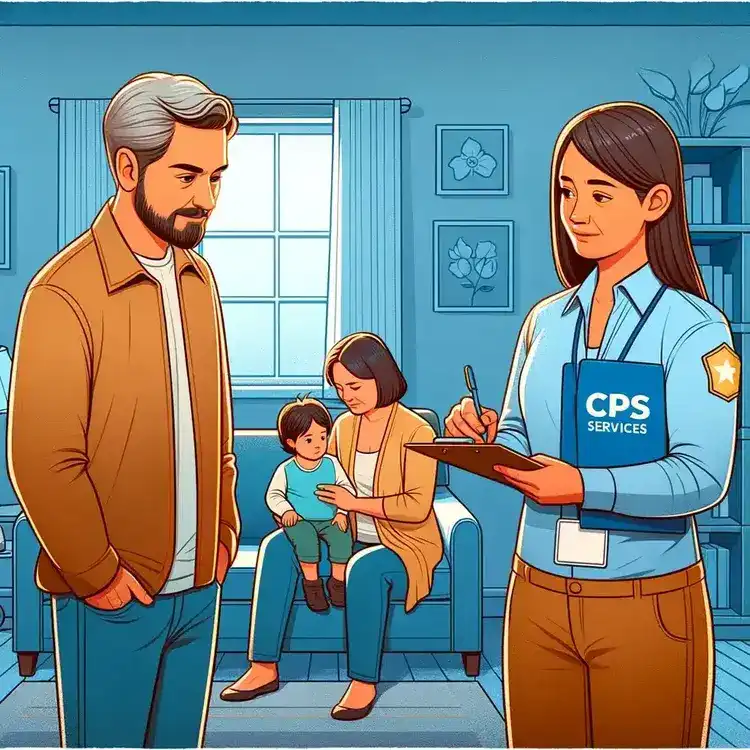When a family faces the distressing involvement of Child Protective Services (CPS), understanding the nuances of the situation is essential. From grasping the agency's role to recognizing your rights, here’s what you need to know to navigate this challenging landscape.
What You Will Learn
- CPS involvement is initiated by reports concerning child safety, including abuse and neglect.
- Understanding the distinction between parental kidnapping and CPS removals can clarify your legal standing.
- Social workers play a crucial role in assessing safety and providing support; engaging positively with them is vital.
- Immediate responses to CPS involvement, such as staying calm and documenting interactions, can greatly influence your case.
- Knowledge of your rights during CPS investigations, including the right to legal representation, is essential for effective advocacy.
- Developing a comprehensive reunification plan demonstrates your commitment to your children's safety and well-being.
- Creating a child safety plan is a critical step in showcasing your responsibility and dedication to CPS.
- Addressing common questions about CPS processes can empower you during this challenging time.
Navigating CPS Involvement: A Process Overview
Understanding the steps and key players involved when Child Protective Services intervenes can help parents navigate this challenging situation.
1. Initial CPS Involvement
Begins with reports of abuse/neglect. CPS investigates to determine child risk. Factors include physical/emotional abuse, neglect, substance abuse, domestic violence.
2. Social Worker Assessment
Social workers assess child safety, develop safety plans, connect families to resources, and monitor compliance with court orders.
3. Legal & Parental Rights
Parents have rights: to be informed of allegations, legal representation, and to appeal decisions. Seek legal counsel immediately.
4. Reunification & Safety
Develop a reunification plan (visitation, classes, stable home) and a child safety plan to demonstrate commitment to CPS.
Understanding the Situation: What to Do if CPS Has Removed Your Children
When Child Protective Services (CPS) becomes involved in a family's life, it can be a daunting experience. It's essential to understand what this involvement means, especially when it escalates to child removal. CPS is typically engaged when there are concerns regarding a child's safety and well-being, often prompted by reports of abuse or neglect. This process aims to protect children and assess the situation, but it can lead to significant emotional and legal challenges for parents.
As someone who has explored various facets of technology and societal issues, I recognize how overwhelming this situation can feel. In the next sections, I'll delve into what CPS involvement entails and how you can navigate this complex process.

Defining Child Protective Services (CPS) Involvement
Understanding CPS's role is crucial for parents facing this reality. CPS involvement begins with reports made to the agency, which then conducts investigations to determine if a child is at risk. Several factors can lead to the involvement of CPS, including:
- Reported incidents of physical or emotional abuse
- Neglect due to inadequate supervision or care
- Substance abuse issues affecting parenting
- Domestic violence within the home
Each case is unique, and the ultimate goal of CPS is to ensure the safety and well-being of the child. For more comprehensive information on child welfare services, you can refer to resources provided by the Child Welfare Information Gateway. Understanding these factors can help parents prepare for the steps ahead.
Clarifying the Difference: Parental Kidnapping vs. CPS Child Removal
It's common to feel a sense of panic when facing CPS involvement, and it's important to recognize the legal distinctions between parental kidnapping and CPS removals. Parental kidnapping involves one parent taking a child without the consent of the other parent or against a court order. In contrast, CPS removal is a legal procedure initiated by the agency to protect a child deemed to be in danger. For detailed information on CPS investigations and parental rights, the Texas Department of Family and Protective Services offers a comprehensive guide. This distinction is vital for understanding your rights and the legal landscape you’re navigating. By clarifying these terms, I hope to alleviate some anxiety and help you feel more informed about the situation.
The Role of Social Workers in CPS Cases
Social workers are central figures in CPS cases, serving as the bridge between families and the agency. They are responsible for assessing the safety of the child and making recommendations for their welfare. Key responsibilities of social workers include:
- Conducting thorough investigations of reported cases
- Developing safety plans for children and families
- Connecting families with resources and support services
- Monitoring compliance with court orders and safety plans
Understanding the role of social workers can empower parents to engage constructively with them and utilize their support effectively during this challenging time.
Immediate Steps to Take After CPS Involvement
When CPS has taken your children, it is critical to act quickly and thoughtfully. The immediacy of your response can influence the outcome of your case. Here are essential steps to consider:
- Stay Calm: Emotions can run high, but staying composed is key.
- Understand the Reasons: Ask for clarity on why CPS was involved and what the specific concerns are.
- Document Everything: Keep records of all communications with CPS and any other relevant documents.
Your initial reactions and actions can significantly impact the trajectory of your case, so it’s important to remain proactive and informed.
Emergency Custody Procedures: How to React
If children are removed, knowing the emergency custody procedures is crucial. Here’s a practical guide on how to react:
- Request an explanation of the removal process from CPS immediately.
- Inquire about the location of your children and visitation rights.
- Seek legal advice as soon as possible to understand your options.
By taking these steps, you not only protect your rights but also begin to lay the groundwork for a potential reunification.
Navigating CPS Processes: Your Rights and Options
During CPS investigations, parents have specific rights that can help guide their actions. Understanding these rights is paramount:
- The right to be informed of the allegations against you.
- The right to have legal representation present during interviews.
- The right to appeal decisions made by CPS.
Knowing your rights can empower you to advocate for yourself and your children effectively. For example, the New York State Office of Children and Family Services provides detailed information on CPS investigations, including parental rights. This understanding can be the difference between feeling overwhelmed and taking control of your situation.
Understanding Legal Representation in CPS Cases
Having legal representation during CPS confrontations is not just advisable; it's often essential. An attorney can:
- Help you understand the legal processes involved.
- Provide guidance on how to interact with CPS and social workers.
- Represent you in court to advocate for your parental rights.
As someone who values informed decision-making, I encourage you to seek legal counsel early in the process. This proactive step can greatly enhance your ability to navigate the complexities of CPS involvement.
Pro Tip
It's crucial to maintain open lines of communication with your assigned social worker. Building a rapport can facilitate a more collaborative approach to your case and demonstrate your commitment to addressing any concerns. Always ask questions if you're unclear about the process or your rights—this shows your engagement and helps you stay informed.
Moving Forward: Steps Towards Reunification and Advocacy
When facing the challenges of CPS involvement, it’s essential to have a clear path forward. Reunification with your children is not just about legal processes; it’s about nurturing your relationship and demonstrating your commitment to their well-being. Here are a few steps you can take to facilitate this journey:
- Engage positively with CPS and communicate openly about your intentions.
- Document your interactions and agreements with CPS to maintain clarity.
- Build a support system that includes family, friends, and professionals.
By actively participating in the process and showing your dedication, you can create a supportive environment that fosters reunification and strengthens your family bonds.

Creating a Plan for Reunification with Your Children
Working constructively with CPS involves developing a robust reunification plan. This plan should outline actionable steps that demonstrate your commitment to providing a safe and nurturing environment for your children. Here are key components to consider:
- Setting regular visitation schedules to maintain connections.
- Identifying any required services or programs (e.g., parenting classes).
- Establishing a stable living environment, including safety assessments.
Presenting a well-thought-out plan can significantly impact the reunification process and show CPS that you are proactive in your approach.
The Importance of a Child Safety Plan
Creating and presenting a child safety plan to CPS is a crucial step in the reunification process. This plan acts as a formal agreement that outlines how you will ensure your child’s safety and well-being. Here are critical elements to include in your safety plan:
- Designating a safe environment free from any hazards.
- Detailing emergency contacts and procedures in case of urgent situations.
- Incorporating any necessary resources, such as counseling or medical support.
By having a comprehensive child safety plan, you demonstrate to CPS that you take your responsibilities seriously and are committed to your children's welfare.
Frequently Asked Questions: Addressing Urgent Concerns
As a parent, navigating the complexities of CPS can raise many urgent questions. Here are some direct answers to common queries you might have:
- What triggers CPS involvement? CPS involvement is typically initiated by reports of suspected child abuse or neglect, which can include physical harm, emotional abuse, inadequate supervision, substance abuse by caregivers, or domestic violence in the home.
- What's the difference between parental kidnapping and CPS child removal? Parental kidnapping occurs when one parent takes a child without the other parent's consent or in violation of a court order. CPS child removal, conversely, is a legal procedure initiated by the agency to protect a child deemed to be at risk of harm.
- What are my rights during a CPS investigation? You have the right to be informed of the allegations against you, the right to legal representation during interviews and court proceedings, and the right to appeal CPS decisions.
- How important is legal representation in a CPS case? Legal representation is highly advisable, as an attorney can help you understand complex legal processes, guide your interactions with CPS, and advocate for your parental rights in court.
- How can I work towards reuniting with my children? To work towards reunification, you should engage positively with CPS, follow all outlined requirements in your reunification plan (e.g., visitations, parenting classes), establish a stable living environment, and create a comprehensive child safety plan.
- Can I get my children back from CPS quickly? The timeline for reunification varies significantly based on the specific circumstances of your case, your cooperation with CPS, and your ability to meet the requirements of your reunification plan. Active engagement and adherence to the plan can help expedite the process.
- What if I disagree with CPS decisions? You have the right to voice your concerns and appeal decisions made by CPS. It is crucial to document your disagreements and communicate them clearly with your caseworker and legal counsel.
- What support is available to families involved with CPS? Many resources are available, including legal aid services, family support programs, parenting classes, counseling services, and substance abuse treatment, all designed to help you navigate the challenges of CPS involvement and work towards family stability.
Addressing these concerns head-on can help you feel more empowered and informed as you move forward in your journey.
Recap of Key Points
Here is a quick recap of the important points discussed in the article:
- CPS involvement typically occurs due to concerns about a child's safety, including abuse, neglect, or domestic violence.
- Understand the difference between parental kidnapping and CPS removal to navigate your rights effectively.
- Stay calm and document all interactions with CPS to influence the outcome of your case positively.
- Seek legal representation early to ensure you understand your rights and options during the CPS process.
- Create a comprehensive child safety plan that outlines how you will ensure your child's well-being.
- Engage positively with CPS and maintain open communication to facilitate reunification with your children.






